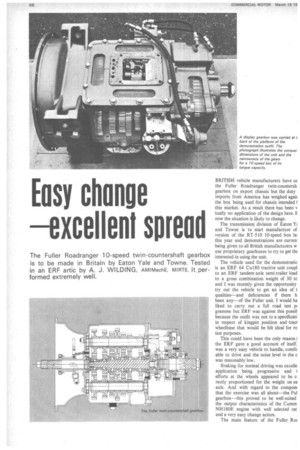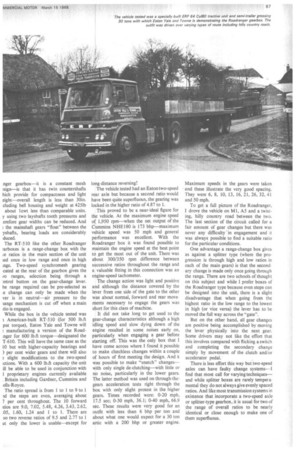Easy change excellent spread
Page 68

Page 69

If you've noticed an error in this article please click here to report it so we can fix it.
The Fuller Roadranger 10-speed twin-countershaft gearbox is to be made in Britain by Eaton Yale and Towne. Tested in an ERF artic by A. J. WILDING, AM1MechE, M1RTE, it.performed extremely well.
BRITISH vehicle manufacturers have us the Fuller Roadranger twin-coontersh gearbox on export chassis but the duty imports from America has weighed agaii the box being used for chassis intended ] this market. As a result there has been v tually no application of the design here. E now the situation is likely to change.
The transmission division of Eaton Yi and Towne is to start manufacture of version of the RT-510 10-speed box lai this year and demonstrations are currert being given to all British manufacturers w use proprietary gearboxes to try to get th( interested in using the unit.
The vehicle used for the demonstratio is an ERF 64 Cul80 tractive unit coupl to an ERF tandem-axle semi-trailer load to a gross combination weight of 30 to and I was recently given the opportunity try out the vehicle to get an idea of t qualities—and deficiencies if there h been any—of the Fuller unit. I would ha liked to carry out a full road test pi gramme but ERF was against this possit because the outfit was not to a specificati in respect of kingpin position and trac1 wheelbase that would be felt ideal for ro test purposes.
This could have been the only reason the ERF gave a good account of itseffi was a very easy vehicle to handle, coml.° able to drive and the noise level in the c was reasonably low.
Braking for normal driving was excelle application being progressive and 1 efforts at the wheels appeared to be c, rectly proportioned for the weight on ea axle. And with regard to the compora that the exercise was all about—the Ful gearbox—this proved to be well-suited the output characteristics of the Cumm NH180E engine with well selected rat and a very easy change action.
The main feature of the Fuller Iltx nger gearbox—it is a constant mesh :sign—is that it has twin countershafts hich provide for compactness and light eight—overall length is less than 30m. chiding bell housing and weight at 4251b about Icwt less than comparable units. y using two layshafts tooth pressures and erefore gear widths can be reduced. And ; the mainshaft gears "float" between the yshafts, bearing loads are considerably duced.
The RT-510 like the other Roadranger :arboxes is a range-change box with the ie ratios in the main section of the unit 3ed once in low range and once in high Lnge. Two-speed synchromesh gearing cated at the rear of the gearbox gives the to ranges, selection being through a )ntrol button on the gear-change lever. he range required can be pre-selected as e change can only be made when the ver is in neutral—air pressure to the iange mechanism is cut off when a main Ltio is engaged.
While the box in the vehicle tested was American-built RT-510 (for 500 lb.ft put torque), Eaton Yale and Towne will : manufacturing a version of the Roadmger for 600 lb.ft torque—designated the T-610. This will have the same case as the 10 but with higher-capacity bearings and ) per cent wider gears and there will also ) slight modifications to the two-speed :ctions. With a 600 lb.ft capacity the unit ill be able to be used in conjunction with 1 proprietary engines currently available • Britain including Gardner, Cummins and oils-Royce.
The ratio spread is from 1 to 1 to 9 to 1 id the steps are even, averaging about 7 per cent throughout. The 10 forward ttios are 9.0, 7.02, 5.48, 4.26, 3.43, 2.62, .05, 1.60, 1.24 and 1 to I. There are so two reverse ratios of 9.5 and 2.77 to 1 at only the lower is usable—except for long-distance reversing!
The vehicle tested had an Eaton two-speed rear axle but because a second ratio would have been quite superfluous, the gearing was loeked in the higher ratio of 4.87 to 1.
, This proved to be a near-ideal figure for the vehicle. At the maximum engine speed 01 1,950 rpm—when the net output of the Cummins NHE180 is 173 bhp—maximum vehicle speed was 50 mph and general performance was excellent. With the R,oadranger box it was found possible to maintain the engine speed at the best point to get the most out of the unit. There was about 300/350 rpm difference between stccessive ratios throughout the range and a, valuable fitting in this connection was an Ogine-speed tachometer.
The change action was light and positive and although the distance covered by the lever from one side of the gate to the other was about normal, forward and rear movements necessary to engage the gears was sbort for this class of machine.
It did not take long to get used to the gar-change characteristics although a high i4ling speed and slow dying down of the e gine resulted in some noises early on, particularly when engaging a gear before siarting off. This was the only box that I have come across where I found it possible to make clutchless changes within a couple of hours of first meeting the design. And it
ias possible to make "snatch" changesith only single de-clutching—with little or noise, particularly in the lower gears. he latter method was used on through-thegars acceleration tests right through the bbx with only slight protest in the higher gars. Times recorded were: 0-20 mph, 0.5 sec; 0-30 mph, 36.1; 0-40 mph, 66.9 sec. These results were very good for an outfit with less than 6 bhp per ton and about what one would expect for a 30 ton artic with a 200 bhp or greater engine.
Maximum speeds in the gears were taken • and these illustrate the very good spacing. They were 6, 8, 10, 13, 16, 21, 26, 32, 41 and 50 mph.
To get a full picture of the Roadranger, I drove the vehicle on Ml, AS and a twisting, hilly country road between the two. The last section of the circuit called for a fair amount of gear changes but there was never any difficulty • in engagement and it was always possible to find a suitable ratio for the particular conditions.
One advantage a range-change box gives as against a splitter type (where the progression is through high and low ratios in each of the main gears) is that the secondary change is made only once going through the range. There are two schools of thought on this subject and while 1 prefer boxes of the Roadranger type because even steps can be designed into the unit, there is a slight disadvantage that when going from the highest ratio in the low range to the lowest in high (or vice versa) the lever has to be moved the full way across the "gate".
But on the other hand, all gear changes are positive being accomplished by moving the lever physically into the next gear. Some drivers may not like the effort that this involves compared with flicking a switeh and completing the secondary change simply by movement of the clutch and/or accelerator pedal.
There is less effort this way but two-speed axles can have faulty change systems—I find that most call for varying techniques— and while splitter boxes are rarely temperamental they do not always give evenly spaced ratios. And like most transmission systems in existence that incorporate a two-speed axle or splitter-type gearbox, it is usual for two of the range of overall ratios to be nearly identical or close enough to make one of them superfluous.




































































































































